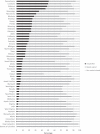The Effect of Incomplete Death Certificates on Estimates of Unintentional Opioid-Related Overdose Deaths in the United States, 1999-2015
- PMID: 29945473
- PMCID: PMC6055296
- DOI: 10.1177/0033354918774330
The Effect of Incomplete Death Certificates on Estimates of Unintentional Opioid-Related Overdose Deaths in the United States, 1999-2015
Abstract
Objectives: A complete and accurate count of the number of opioid-related overdose deaths is essential to properly allocate resources. We determined the rate of unintentional overdose deaths (non-opioid-related, opioid-related, or unspecified) in the United States and by state from 1999 to 2015 and the possible effects of underreporting on national estimates of opioid abuse.
Methods: We abstracted unintentional drug overdose deaths ( International Classification of Diseases, 10th Revision, codes X40-X44) with contributory drug-specific T codes (T36.0-T50.9) from the Mortality Multiple Cause Micro-Data Files. We assumed that the proportion of unspecified overdose deaths that might be attributed to opioids would be the same as the proportion of opioid-related overdose deaths among all overdose deaths and calculated the number of deaths that could be reallocated as opioid-related for each state and year. We then added these reallocated deaths to the reported deaths to determine their potential effect on total opioid-related deaths.
Results: From 1999 to 2015, a total of 438 607 people died from unintentional drug overdoses. Opioid-related overdose deaths rose 401% (from 5868 to 29 383), non-opioid-related overdose deaths rose 150% (from 3005 to 7505), and unspecified overdose deaths rose 220% (from 2255 to 29 383). In 5 states (Alabama, Indiana, Louisiana, Mississippi, and Pennsylvania), more than 35% of unintentional overdose deaths were coded as unspecified. Our reallocation resulted in classifying more than 70 000 unspecified overdose deaths as potential additional opioid-related overdose deaths.
Conclusions: States may be greatly underestimating the effect of opioid-related overdose deaths because of incomplete cause-of-death reporting, indicating that the current opioid overdose epidemic may be worse than it appears.
Keywords: death; death certificates; drug overdose; epidemics; opioids.
Conflict of interest statement
Figures



References
-
- Chen LH, Hedegaard H, Warner M. Quickstats: rates of deaths from drug poisoning and drug poisoning involving opioid analgesics—United States, 1999-2013. MMWR Morb Mortal Wkly Rep. 2015;64(1):32.
-
- Warner M, Chen LH, Makuc DM, Anderson RN, Minino AM. Drug poisoning deaths in the United States, 1980-2008. NCHS Data Brief. 2011;81:1–8. - PubMed
-
- Buchanich JM, Balmert LC, Pringle JL, Williams KE, Burke DS, Marsh GM. Patterns and trends in accidental poisoning death rates in the US, 1979-2014. Prev Med. 2016;89:317–323. - PubMed
-
- Jones CM, Mack KA, Paulozzi LJ. Pharmaceutical overdose deaths, United States, 2010. JAMA. 2013;309(7):657–659. - PubMed
MeSH terms
Substances
LinkOut - more resources
Full Text Sources
Other Literature Sources

